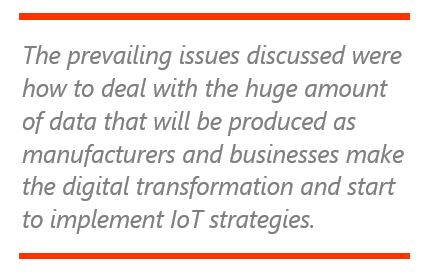

At the recent ARC Industry Forum in Orlando, Florida, the session: From Chips to the Cloud: AI Drives the Intelligent Edge examined some important trends surrounding the current state of edge computing and the maturity of key technologies that are converging to drive and enable the Industrial IoT.
ARC Senior Analyst, Dick Slansky, moderated the session and provided an overview of the topic and content the session covered. The prevailing issues discussed were how to deal with the huge amount of data that will be produced as manufacturers and businesses make the digital transformation and start to implement IoT strategies.Architectures, as well as how to best utilize the edge devices that will collect the required data, were other key topics.

Dr. Henning Löser, Senior Manager, Audi Production Lab, and Albert Rooyakkers, CEO, Bedrock Automation also presented in this session. Each of the presenters addressed issues that manufacturers face today as they progress along the path to digital transformation. These include dealing with the realities of implementing the Industrial IoT and the associated enabling technologies. Dr. Löser discussed the issues around using artificial intelligence (AI) and predictive analytics in automotive production. Mr. Rooyakkers, in turn, talked about embedded AI, edge computing, and security at the intelligent edge. Both speakers clearly addressed the realities and issues manufacturers will be dealing with relative to implementing Industrial IoT strategies, including the trust and management of the large volumes of data that will be involved in this transition.
While there is consensus that the edge devices and connected sensors will produce large amounts of data, it was pointed out that handling all those data remains the key issue. The current discussion revolves around where these data will be processed: in the Cloud or on the edge, and by whom.
The edge will become more intelligent by necessity. Moving massive amounts of device and sensor data through the Cloud will be too slow to efficiently process the operational data required in a real-time factory production environment. The consensus forming is that embedded intelligent in edge devices powered by next-generation AI processors and inferenced-based machine learning will drive the future of IoT.
There is debate about where all the data will be processed. Cloud platform providers maintain that massively scaled data centers can do the job. Conversely, device and chip makers maintain that much of the data can be processed at the source with embedded intelligence and purpose-built AI and machine learning (ML) in the devices. The axiom among controls and automation engineers has always been that the closer the data is to the process, the better.
It was pointed out that the machine learning landscape will involve both the Cloud and the edge. ML, a subset of AI, uses mathematical probability and pattern matching to learn through training algorithms. This training takes place in the Cloud where there is typically large-scale, resource-intensive computing that processes the mass of data collected to build the training algorithms. The ML inferencing is performed in specialized processors in the edge device. Once trained, these devices will be able to process more data through inferencing engines embedded in the processors.
Dr. Löser presented a look at how Audi production is using AI and predictive analytics to optimize the spot-welding process in its body-in-white production lines. But more importantly, he pointed out how Audi is implementing the virtualization of its automation systems on the factory floor.
Dr. Löser noted that the spot-welding process is highly consistent and anomalies rare, so capturing data on these anomalies is extremely valuable for re-training the algorithms. The new, cloud-trained algorithms are then introduced into the factory production systems to improve the process. But changing to the new software in the many individual automation devices and controls is time-consuming and disruptive to production lines. Dr. Löser here introduced the new paradigm of automation that Audi is adopting: virtualization of automation on the shop floor. Before, if Audi production needed a specific function, it had to buy a new, purpose-built “box” (automation device) to provide it. Now, the company can introduce new software to provide the upgrade through virtualized/containerized software that runs on general-purpose hardware.
ARC Advisory Group clients can view the complete report at ARC Client Portal
If you would like to buy this report or obtain information about how to become a client, please Contact Us
Keywords: Cloud Computing, Intelligent Edge, Industrial IoT, AI, Machine Learning, Virtual Automation, Data Security, Embedded Encryption, ARC Industry Forum, ARC Advisory Group.

